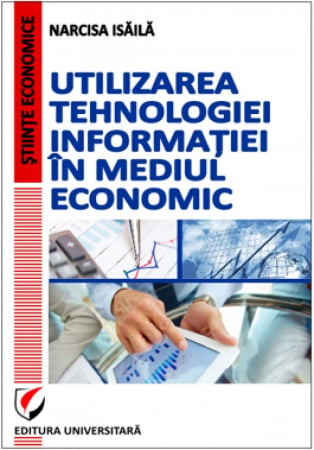ISBN: 978-606-28-0871-6
DOI: 10.5682/9786062808716
Publisher year: 2019
Pages: 112
Publisher: Editura Universitară
Edition: I
Author: Roxana Arabela Dumitrascu
- Download (1)
- Authors
- Content
- More details
- Reviews (0)
-
Controlling
Download
Education:
Faculty of Economics, University "Petre Andrei" of Iasi, specializing in Finance and Accounting (2001);
Post-graduate School of the University FIBAS "Al. I. Cuza" Iasi, master's degree in Economics and Financial Management & Banking (2005);
Academy of Economic Studies (2010), PhD in Finance;
Romanian Academy, SPODE, post-doctoral studies in economics.
Activity:
2001-2011 professor at the Faculty of Economics of the University "Petre Andrei" of Iasi;
2012 Ph.D. Lecturer at the Faculty of Finance, Banking and Accounting, of Christian University "Dimitrie Cantemir" of Bucharest, owner of enterprise financial management courses, insurance and reinsurance and risk management in insurance and reinsurance.
Publications:
Single author: Financial management company. Self-study manual (2012), Insurance and reinsurance. Self-study manual (2012), Prices and and competitivity. Self-study manual (2012), Management of the goodwill value (2008).
Coauthor: Intangible firm capital management (2009), Drift Management (2005), Management versus postmodernity (2005), Defiance complexity (2004), Elements of evaluating companies (2002).
Over 70 articles and studies published in scientific journals.
Chapter 1
Introductory notions regarding controlling / 7
1.1. The notion of controlling / 7
1.2. Relationship controlling - management / 13
1.3. Integration of controlling in the general management system / 16
1.4. Costs - essential dimension of controlling / 19
1.5. Questions and tests / 27
Chapter 2
Enterprise budgets / 30
2.1. The business plan of an enterprise / 30
2.2. The overall budget of the enterprise / 35
2.3. Revenue and expenditure budget / 49
2.4. Questions, tests and applications / 54
Chapter 3
Operational controlling / 59
3.1. Risk at enterprise level / 59
3.2. Profitability threshold / 66
3.3. Structural exploitation risk / 70
3.4. Sensitivity of the result in relation to the activity volume / 75
3.5. Controlling the cash flows of the enterprise / 77
3.6. Questions, tests and applications / 83
Chapter 4
Strategic controlling / 90
4.1. Strategy focused on sustaining the life cycle of the enterprise / 91
4.2. Strategy for optimizing the portfolio of activities / 92
4.3. Investment efforts optimization strategy / 97
4.4. Strategy for optimizing the financial structure and the cost of capital attracted by the enterprise / 100
4.5. The strategy of maximizing the economic value of the enterprise / 102
4.6. Questions and tests / 107
Bibliography / 109
Controlling is a managerial function through which:
• performance monitoring is performed and measures are designed to effectively achieve the desired results;
• ensures that the right things happen effectively, in the right ways and at the right time.
In this way, effective controlling guides the activities and efforts of employees and work groups in accordance with short-term and long-term plans, ensuring that performance objectives and concrete actions to achieve them are achieved. Therefore, controlling helps maintain the compliance of real business operations with essential organizational rules and policies.
An efficient controlling system has the basic features of a cybernetic system:
• is structurally autonomous in relation to the operational system it pilots, respectively independent in its capabilities for monitoring and correcting performance;
• is based on the identification and monitoring of the regulation circuits through feedback and feed-before that support the functioning of the business organization.
The controlling process at the level of the business organization has the following structure:
establishing performance objectives and activity standards;
measuring the effective performance;
comparing the actual results with the objectives and standards and identifying the deviations;
designing, organizing and implementing the necessary adjustment / correction measures.
The first phase of the controlling process begins with planning and establishing performance objectives and standards and ways to measure them. There are two types of standards:
• output standards, which measure performance results in terms of quantity, quality, cost or execution time;
• input standards, which measure the specific economic efforts that determine the achievement of a performance task.
Regarding the measurement of effective performances, the second phase of the controlling process, it must comply with the following technical requirements:
the measurements must be sufficiently accurate to detect deviations or variations between what is really happening and what is most desirable;
establishing the deviations and variations is not, in itself, sufficient, being necessary also the correct identification of the factors that caused these deviations.
Comparing the actual performance with the desired performance - the third phase of the controlling process - establishes the need for action. In this sense, it is of utmost importance to discover and understand perfectly the causal relationships that characterize the functioning of the monitored system. It is essential, in this phase, to avoid confusions between the correlation relations that may exist between different variables or parameters of the monitored system and the cause-effect relations, the last category representing the object of a special attention from the controlling function. Among the main ways of making these comparisons are: historical analysis (comparison of results obtained with average or relevant values recorded by the organization in various previous periods), relative diagnosis (comparison of actual performance with various technical, financial or legal regulations), benchmarking (comparing the overall or functional performance of the company with similar results obtained by other business organizations, which, in this way, serve as a "benchmark" or benchmarks in terms of efficiency) etc.
The last (fourth) phase of the controlling process - taking the necessary actions to correct or improve effective performance - summarizes virtually all the informational, analytical and conceptual efforts consumed in the previous phases, measuring the effectiveness of the entire controlling process. One of the main ways to achieve this phase is exceptional management, which focuses management's attention on substantial differences between real and desired performance, imposing decisional and organizational intervention of the higher hierarchical factor only in such situations, considered exceptions and leaving to subordinates competence autonomous adjustment of deviations and insignificant variations. Practicing exceptional management saves the time and energy of managers and other resources, while focusing organizational efforts on the areas that have the greatest need for decision-making and operational intervention. In cybernetic terms, exceptional management facilitates the simultaneous use of hierarchical regulation and self-regulation of the monitored system.
Two types of exceptions can be highlighted:
• problems, those situations in which the actual performances present values below the established standards;
• the opportunities, which correspond to the situations in which the actual results registered by the business organization take values above the standards set by the management.
Each type of exception requires a special kind of organizational and managerial measures. As the problems signal the existence of latent or active risks, having a serious potential for generating crises and financial, commercial, image and reputation losses, etc., the management's attention will focus on the precise identification of the causes, on the one hand, and designing and implementing as soon as possible a set of measures in order to eradicate them in order to bring the situation back to normal, on the other hand. Opportunities are, on the contrary, carriers of potential future benefits, but which can be used only if the determinants have been captured and understood correctly, and the positive experience and knowledge acquired have been disseminated throughout the organization, thus fueling organizational learning processes. and development of business intellectual capital. This dimension reveals the strategic character of controlling as a managerial function oriented towards the identification, consolidation and capitalization of the sustainable competitive advantages of the business.
The aspects highlighted up to this point allow the formulation of pertinent conclusions regarding the fundamental features of efficient controlling. First of all, a controlling system is strategically oriented, focusing essentially on ensuring the continuity and consistency of the flows of long-term economic results. Secondly, a good controlling system has a minimum level of administrative complexity, being articulated from a small number of procedures as simple as possible, but which manage to capture exactly the main economic processes carried out in the organization. Therefore, the controlling mechanisms must be clear and understandable to all organizational actors involved. Finally, with an emphasis on exceptional management, the controlling system will encourage self-control.
It can be summarized that the efficient functioning of some controlling procedures at the level of the business organization is based on the organic integration of the following principles:
1. time orientation;
2. the exceptionality of the managerial interventions;
3. the positive character, respectively the priority identification of the real causes;
4. fairness and objectivity;
5. flexibility, in the sense of incorporating multivalent information and continuous pursuit of intercorrelated economic dynamics within the organization.
From a structural and procedural point of view, the controlling system of a business organization represents a set of interconnected controls. These controls can be very different in terms of object and content, how they are carried out or the purposes pursued. The categories or types of control that form a controlling system can be classified as follows:
• After the situation in time compared to the economic operation or the monitored performance:
1. Preliminary or preventive controls, carried out before the actual realization of the operation or performance, in order to ensure the technical-economic, financial-accounting and legal conformity of the entries and the other preconditions.
2. Concurrent or simultaneous controls, which focus on verifying what actually happens during the monitored work process. Sometimes they are also called steering controls, because they monitor the operations and activities in progress to ensure that things are done correctly.
3. Post-factum controls, also called feedback controls, which take place after an action is completed, focusing on the final results and not on inputs or activities.
• Depending on the personality of the person performing the control:
1. Internal controls, which allow motivated and responsible workers to exercise their self-control over the way of fulfilling the professional attributions and the obtained performances. The potential for self-control is increased when capable employees have clearly formulated performance objectives and benefit from adequate technical and informational support.
2. External controls, which take place through hierarchical supervision or by an independent control body within or outside the organization. These controls are based on the use of the organization's official administrative procedures, such as, for example, performance appraisal and reporting systems, reward and benefit systems, employee discipline systems, and goal management.
• Depending on the reporting to the strategy and long-term objectives:
1. Operational controls, which are focused on following the current operations carried out by the company and on monitoring the short-term performances. The purpose of this dimension of controlling is to increase the current efficiency by optimizing the exploitation of the resources and capacities held by the company.
2. Strategic controls, which focus on monitoring the degree of fulfillment of long-term performance objectives by promoting the company's development strategies and policies. The purpose of this dimension of controlling is to ensure the sustainability of the business by creating and consolidating sustainable competitive advantages. As projects are one of the main means of achieving business strategy, and investments are its financial support, project controlling and investment controlling are asserted as fundamental dimensions of strategic controlling.
The most important landmarks of controlling a business are the competitive strategy and performance objectives, internal policies and decision-making procedures, internal regulations and discipline, budgets and activity programs, selection criteria and training of human resources, promotion criteria in employees' careers, motivation and rewarding practices, the way of designing jobs and the composition of work formations (divisions, departments, compartments, offices, sections, workshops, etc.), the values and norms that define the organizational culture, etc.
Undoubtedly, the global mission of a controlling system is, as we have seen, to maintain a long-term performance of the business, but this is possible, in turn, only through the systematically correct work behaviors of employees and performance. Good economic results are primarily consequences of good work behaviors. This aspect is the main challenge for modern controlling: determining reliable and quality work behaviors based on attracting talented people and keeping them in the business, motivating people to make maximum efforts in their work, recognizing the value of individual and collective contributions to overall business performance.
The controlling system of the organization must, therefore, be constructed in such a way as to facilitate the follow-up of the way in which the individual efforts and performances of the workers are aggregated and integrated progressively, gradually leading to the formation of the global economic-financial performances. Therefore, controlling must show very clearly and unequivocally how the individual efforts of each worker, regardless of their hierarchical positioning and professional specialization, help to build the overall performance of the entire business. Therefore, the task of controlling is not only to explain whether the business creates value, but also to argue how value is generated and what is the concrete contribution of each member of the organization in this process.
The main notions used in the business controlling activity are:
1) the cost as a financial expression of the economic efforts of the business in order to prepare and carry out the operations, the realization of the products, the service of the clients, the development of the markets and the obtaining of the performances;
2) the added economic value understood as a global financial surplus resulting from the exploitation of the economic assets of the business under the conditions of a certain level of the costs of financing these assets;
3) the profit considered as the difference between the total revenues generated and the total expenses incurred by the business;
4) the cash flow or the cash flow released, considered to be the support of the financial viability of the business, respectively the basis of its payment capacity and sovavability.
The mentioned notions represent, at the same time, important (if not the most important) financial measures of the company's success. Their consistent follow-up allows the rallying of the individual and collective efforts of the workers to the company's operating processes. In conclusion, controlling is the managerial tool that provides and facilitates this connection.

6359.png)
![Controlling - Roxana Arabela Dumitrascu [1] Controlling - Roxana Arabela Dumitrascu [1]](https://gomagcdn.ro/domains/editurauniversitara.ro/files/product/large/controlling-173-106132.jpg)














